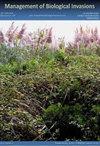Application of electricity and underwater acoustics to clear fish from a navigation lock during maintenance
IF 1.2
4区 环境科学与生态学
Q3 BIODIVERSITY CONSERVATION
引用次数: 0
Abstract
The presence of fish within navigation locks can introduce an environmental challenge for construction crews when maintenance is required. This study examined the effectiveness of a dual-deterrent fish herding technique using electricity and acoustic stimuli to reduce the abundance of fish within a navigation lock before a scheduled dewatering for maintenance. Fixed-location multi-beam imaging sonar was used to evaluate fish per minute (FPM) detections near the lock entrance before, during, and after the herding effort. Standardized mobile side-scan sonar surveys were also conducted before and after the herding to examine fish presence throughout the entire lock. Collectively, a 73% reduction in fish targets detected by side-scan sonar and a 43% reduction in FPM detected by imaging sonar were observed following the herding technique. Post-fish herding, an 88% reduction in FPM > 400 mm and a 35% reduction in FPM < 400 mm were observed. Fish abundance within the lock chamber was reduced and did not result in construction delays, which was problematic and costly during previous dewatering events. Because data from this study are limited to a single lock dewatering and fish clearing event, caution is warranted with the extrapolation of these results. However, the applied methods show promise and may inform future fish clearing efforts to aid lock maintenance.电力和水下声学的应用,以清除在维修期间从导航船闸鱼
当需要维护时,航行船闸内存在的鱼类会给施工人员带来环境挑战。本研究检验了一种双重威慑鱼类放牧技术的有效性,该技术使用电和声刺激来减少航行水闸内鱼类的丰度,然后进行定期脱水维护。固定位置多波束成像声纳用于评估在放牧之前,期间和之后在船闸入口附近的每分钟(FPM)检测。标准化的移动侧扫声纳调查也在放牧前后进行,以检查整个船闸的鱼类存在情况。总体而言,在放牧技术之后,观察到侧扫声纳检测到的鱼目标减少了73%,成像声纳检测到的FPM减少了43%。放养后,400 mm以下的FPM减少88%,< 400 mm的FPM减少35%。锁舱内的鱼类数量减少,并且没有导致施工延误,这在以前的脱水事件中是一个问题和昂贵的问题。由于这项研究的数据仅限于单一的水闸脱水和鱼类清理事件,因此对这些结果的推断需要谨慎。然而,应用的方法显示出希望,并可能为未来的鱼类清理工作提供信息,以帮助维护船闸。
本文章由计算机程序翻译,如有差异,请以英文原文为准。
求助全文
约1分钟内获得全文
求助全文
来源期刊

Management of Biological Invasions
Agricultural and Biological Sciences-Ecology, Evolution, Behavior and Systematics
CiteScore
3.40
自引率
6.70%
发文量
21
审稿时长
16 weeks
期刊介绍:
Management of Biological Invasions, established in 2010 by Dr. Elias Dana, is an open access, peer-reviewed international journal focusing on applied research in biological invasions in aquatic and terrestrial ecosystems from around the world. This journal is devoted to bridging the gap between scientific research and the use of science in decision-making, regulation and management in the area of invasive species introduction and biodiversity conservation.
Managing biological invasions is a crisis science, with Management of Biological Invasions aiming to provide insights to the issues, to document new forms of detection, measurements and analysis, and to document tangible solutions to this problem.
In addition to original research on applied issues, Management of Biological Invasions publishes technical reports on new management technologies of invasive species and also the proceedings of relevant international meetings. As a platform to encourage informed discussion on matters of national and international importance, we publish viewpoint papers that highlight emerging issues, showcase initiatives, and present opinions of leading researchers.
 求助内容:
求助内容: 应助结果提醒方式:
应助结果提醒方式:


